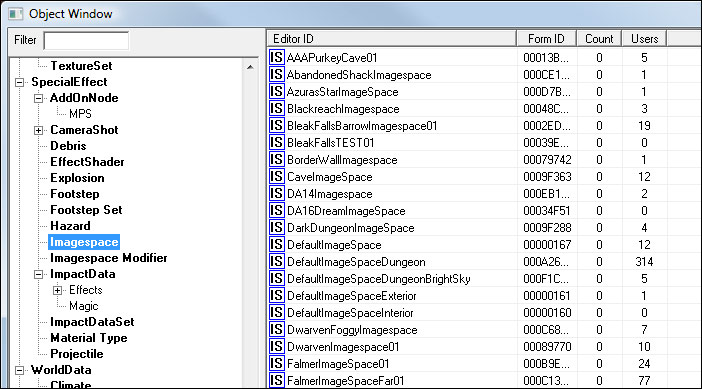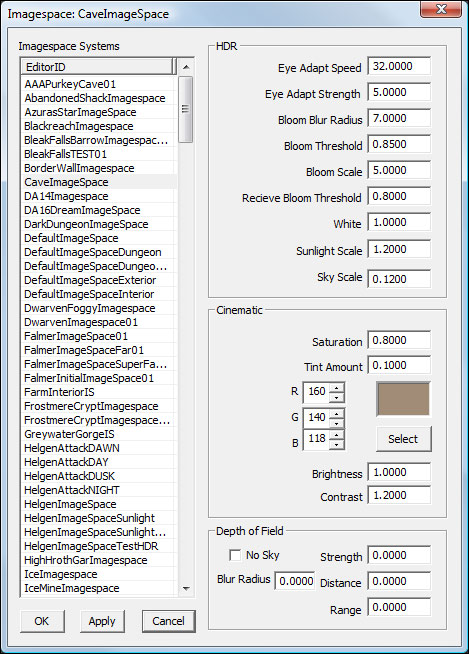ImageSpace
Overview[edit | edit source]
ImageSpace systems can configure the base display effects for a cell or worldspace. This allows designers to drive post-processed "film" effects through the editor, giving much greater control and more of a "film" feel. Some of the effects include blurring, coloring, and HDR/Bloom effects.
ImageSpaces may be applied to individual cells (eg. dungeon) by editing the cell data: right-click on the name of the cell in the Cell View window, choose Edit, then select the ImageSpace from the drop down menu in the middle of the Common data tab.
ImageSpaces may not be applied to worldspaces directly, but may be applied by adding weather to the worldspace. Weather may be added to Climates, which are then associated with worldspaces in the World Spaces dialog, or by adding a region to the worldspace and adding the weather in the Weather tab.
Editor Location[edit | edit source]
ImageSpaces are listed under SpecialEffect in the Object Window. To create a new ImageSpace, right-click on an ImageSpace in the Object Window and select New to open the Imagespace dialog. Right-click on an ImageSpace in the dialog and select New again. This will create a prompt to enter the EditorId of your ImageSpace. Alternately, you may duplicate an existing ImageSpace by choosing Duplicate from the right-click menu.
Data Fields[edit | edit source]
Imagespace Systems: Each system has a unique form editor ID. By right clicking in the window, you can add or duplicate a system.
HDR[edit | edit source]
Parameters for high dynamic range rendering. These values are for calculating RGB settings on the ImageSpace beyond the 255 maximum.
- Eye Adapt Speed: Controls how quickly the adapted scene luminance chases the actual luminance. Between 0.0 and 100.0 representing the percentage of the difference between the adapted scene luminance and the actual luminance that is closed each frame (assuming 30fps).
- A value of 0.0 means the adapted luminance will never change.
- A value of 100.0 will never "chase" so that the adapted luminance is always equal to actual luminance.
- Typical values are in the 2.0-5.0 range.
- Default: 3.0
- Eye Adapt Strength:
- Default: 3.0
- Bloom Blur Radius: The amount of bloom. Integers only. Cannot be turned off.
- 1.0 Min blur.
- 7.0 Max blur.
- Default: 7.0
- Bloom Threshold: Controls the threshold for which pixels in the scene bloom.
- Pixels less bright than this value do not bloom.
- Pixels more bright than this value bloom more the farther they are passed the threshold.
- Default: 0.6
- Bloom Scale: Controls how bright the bloom is.
- Default: 0.5
- Receive Bloom Threshold:
- Default: 0.15
- White:
- Default: 0.15
- Sunlight Scale: (non-imagespace) Scale the sunlight.
- Default: 1.8
- Sky Scale: (non-imagespace) Scale the sky.
- Default: 1.5
Cinematic[edit | edit source]
Enables tint, brightness, saturation, and/or contrast modifiers.
- Saturation: Increases the saturation of the screen. Setting the number to a negative will reverse the colors displayed(blue will render yellow...). Setting the saturation to 0 will remove all color from the scene(scene renders black and white).
- Default: 0.9
- Tint Amount: The alpha(opacity) of the colors overlaid. This setting alone will never raise the color level high enough to completely wash out the scene. At a strength of 255 it will render the entire scene in shades of the RGB color.
- Default: 0.0
- Tint:
- R/G/B: Overlays the corresponding color. Strength is from 0 to 255
- Default: 0 0 0 (black)
- Brightness: Increases the brightness, setting either number to 100 causes a create white-out. Setting both to 0 will result in complete darkness.
- Default: 1.5
- Contrast: Amplifies the bright and dark spots in the scene. A negative number here will inverse bright and dark spots and then amplify them accordingly.
- Default: 1.1
Depth of Field[edit | edit source]
- No Sky:
- Default: unchecked
- Strength:
- Default: 0.0
- Blur Radius:
- Default: 0
- Distance:
- Default: 0.0
- Range:
- Default: 0.0

